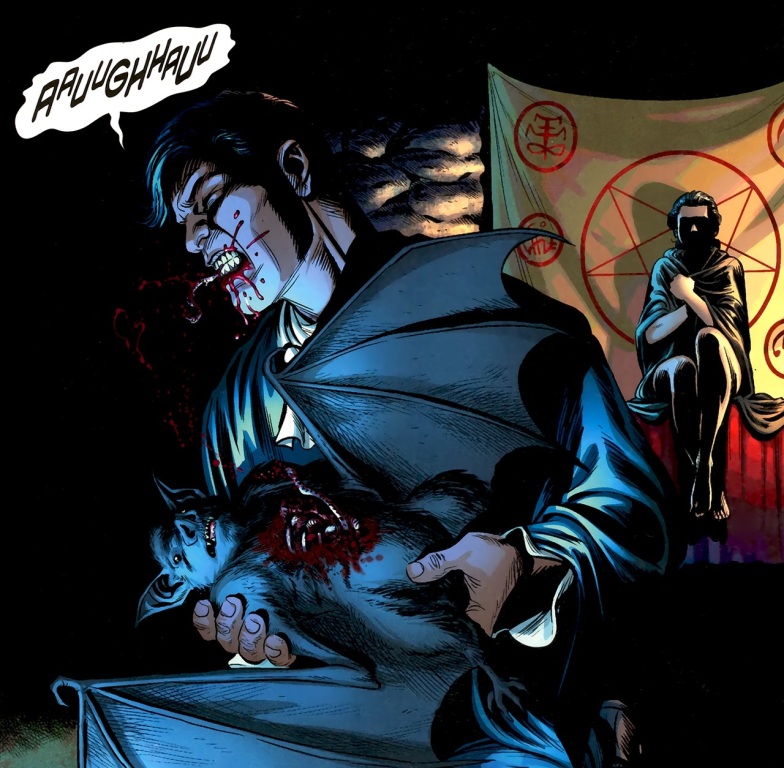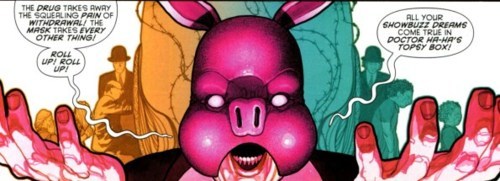
Christopher Nolan wasn’t the only artist to successfully re-imagine Gotham’s Dark Knight over the course of the last decade….
The publication of the final issue of Batman Incorporated in July 2013 brought an end to Grant Morrison’s seven-year run on Batman, an epic and multifaceted arc during which the writer reinvigorated classic characters and made some bold and, at times, controversial storytelling decisions. While some long-term fans still angrily insist that Morrison “ruined” Batman during his time on the title, it’s hard to think of any other run in mainstream superhero comics with such a consistently high level of quality throughout the whole of its long duration. Morrison’s masterstroke was to simultaneously revere and pervert Batman’s long and illustrious history in comic books, making references to obscure stories from the Dark Knight’s entire back catalogue while at the same time drawing new, mind-bending meanings from them. This approach allowed him to answer some very old questions from the character’s past in original and unexpected ways, all the while staying true to the essence of Batman and simply telling an utterly engrossing story about the character. With the aid of talented artists like Andy Kubert, Tony Daniel, Frank Quitely and Frazer Irving, Morrison also brought his love of symbolism to the comic, reconfiguring the exploits of the Dark Knight as modern pop-culture myths sketched on a grand scale. In short, Morrison created nothing less than a seven-year-long masterpiece.

Dr Simon Hurt
All throughout his run, Morrison clearly delighted in digging up pieces of Batman’s past which had failed to make the cut of recent established continuity. No storyline from the character’s 67-year history was considered off-limits, meaning a wealth of wacky storytelling possibilities which at times sat uneasily next to the grim and grittily realistic portrayal of Batman which has come to dominate since the 1980s. The Batman and Son arc which began Morrison’s run drew upon one such non-canonical story, 1987’s Son of the Demon, in bringing back the character of Damian, Bruce Wayne’s illegitimate son with Talia al Ghul. Damian’s arrival in the Wayne household and the upheaval it causes form the point of departure for Morrison’s story, although from early on there’s also a sense of something darker lurking in the background, an ancient and sinister presence marshaling its forces against the Dark Knight and his closest allies. In the Black Glove and Batman RIP story arcs this conspiracy reveals itself, and, led by the mysterious and demonic Dr Hurt, proceeds to wage all-out war against Batman. Drawing upon the more fantastical side of Batman’s publication history, which has fallen out of favour with comics writers in recent years, Morrison uses Satanic symbolism and ominous fragments of dialogue to imply a supernatural dimension to Batman’s newest enemies, giving hints as to the terrible true identity of Hurt. This melding of down-to-earth realism and dark fantasy continually keeps the reader guessing, and rather than being frustrating actually serves to create an effective atmosphere of mystery and suspense. Running in parallel with the story of the Black Glove is Morrison’s thrilling reinvention of the Joker, a piece of character development which proves to be one of the highlights of the entire run. After being shot in the head by a Batman impersonator at the very beginning of Batman and Son, Gotham’s most iconic villain undergoes one of his regular metamorphoses (a neat way of explaining the character’s changes in personality down the years), and emerges more dangerous and unpredictable than ever. This new Joker proves to be a true wild card, and the fascinating direction in which Morrison takes him leads to some of the series’ most memorable moments.

Joker reborn
Given that one of the series’ collections is called The Return of Bruce Wayne, it hardly seems like a spoiler to note that, despite the ominously titled Batman RIP story arc, Bruce Wayne does not die during Morrison’s run. Rather, it is Batman as a symbol which is in danger of being corrupted and wiped out, and this is indeed what Dr Hurt and his minions strive to achieve on their unholy crusade. The symbolic power of Batman is one of the series’ main themes, and finds its fullest expression in the pages of Final Crisis, DC’s company-wide crossover which was scripted by Morrison and featured important story developments for his Batman series. The confrontation between Batman and the alien god Darkseid elevates the character and his actions to the level of myth, and allows Morrison to cast Bruce Wayne as the thematic descendant of Greek demigods and Athurian knights as he embarks upon a fantastic voyage that will take him to the end of the universe and force him to confront dark secrets from his family’s past. In his absence, Dick Grayson and Damian Wayne take over as the new dynamic duo in the Batman & Robin arc, which sees the introduction of horrifying new villain Professor Pyg as well as the return of the Joker and other, more mysterious enemies. In Morrison’s hands, Grayson emerges as a worthy Batman who does justice to the cape and cowl without becoming a mere clone of his mentor, and it’s a shame that DC’s New 52 reboot has ensured there won’t be any more stories featuring his Batman (although Scott Snyder and Jock’s fantastic Black Mirror is highly recommended). The explosive conclusion of Batman & Robin leads directly into the saga’s swansong, Batman Incorporated, a globetrotting adventure story in which Batman and his titular network of allies come up against an international crime syndicate called Leviathan. Despite its epic scope, this final arc in many ways brings the whole of Morrison’s Batman story full circle, descending from the mythic heights of earlier volumes to tell a grittier tale of flawed parents and angry children, laced with a sense of tragedy that resonates with the very origins of the character.

Batman returns
What makes the entire saga such a rewarding read is that it can be enjoyed on more than one level; while a compelling story of dysfunctional families, dark conspiracies and the battle between good and evil unfolds, Morrison packs almost every panel with symbols and deeper meaning. Several motifs crop up repeatedly, including the red and black colour scheme which takes on numerous meanings throughout the story; ominous references to “the hole in things”, hinting at a hidden, malign influence which manifests itself in various horrifying forms; and the character of Ellie, who, saved by Batman from a life on the streets, ultimately manages to return the favour more than once. These myriad threads running just beneath the surface of the main narrative, along with Morrison’s penchant for distorting characters’ perceptions and playing around with the depiction of time (several characters and events are referenced dozens of issues before they become significant) make his Batman saga a rich mosaic of twisted storylines and striking, hallucinatory imagery which rewards multiple readings.

Professor Pyg
But the comic isn’t just a parade of big ideas and psychedelic visions, because characters are always at the heart of the story. Morrison’s fresh take on familiar faces, and his introduction of some memorable new ones, works well, building on decades of character continuity to find new directions for a well-worn gallery of heroes and villains. At the centre of the narrative, of course, is Bruce Wayne, the character whose personal journey drives the entire story. Morrison riffs on almost every depiction of Batman from the last 70 years during his run, including Christopher Nolan’s recent film series. Like those films, Morrison initially shows Bruce becoming lost in his Batman persona, before letting the character unfold and develop in ways rarely seen on either the page or the screen. From Batman and Son to Batman Incorporated, Bruce goes from methodical crime-fighter to raving madman to Machiavellian tactician, his actions accompanied at all times by rather sinister undertones. His eventual realisation that Batman’s greatest strength has always been his friends and allies leads him to create Batman Incorporated, but this bizarre surrogate family cannot replace the genuine emotional bonds which he seems unable or unwilling to form. Although Bruce’s awkward relationship with Damian takes something of a back seat in the middle of the story, it holds centre stage at the beginning and end, giving Morrison another way to explore the deep and abiding emotional impact of Batman’s traumatic origin.

Batman and son
Morrison’s run on Batman was ultimately about reinventing the Dark Knight while still capturing the essence of the character, and in this he succeeded magnificently. While the comic does stray a little too far into smug self-awareness at times (one battle, for example, takes place in a pop-art gallery with sound effects provided by the paintings), it remains an unashamed celebration of superhero comics rather than an attempt to alter them beyond recognition. By stretching, but not breaking, the boundaries of what makes a Batman comic, Morrison proved once again that you can tell complex, profound and thought-provoking stories through the near-mythic exploits of superheroes. In the process, he also managed to create one of the greatest Batman stories ever written.
Grant Morrison’s entire Batman saga is collected in the following trades (listed in reading order):
Batman and Son The Black Glove Batman RIP Final Crisis* Time and the Batman Batman & Robin: Batman Reborn Batman & Robin: Batman vs. Robin The Return of Bruce Wayne Batman & Robin: Batman Must Die Batman Incorporated vol 1 Batman Incorporated: Demon Star Batman Incorporated: Gotham’s Most Wanted*Final Crisis is not technically part of the series, but features important plot developments.
